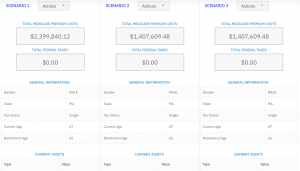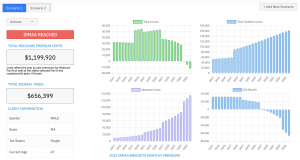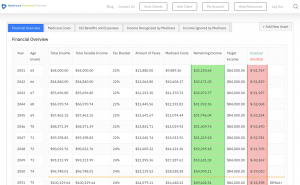The social security tax limit 2024 is a crucial number for both employees and employers. It’s not just a dry figure – it reflects the financial health of Social Security and raises concerns about its future. Let’s take a closer look.
Understanding the Social Security Tax Limit for 2024
In 2024, the social security tax limit is set at $168,600, a notable increase from the $160,200 limit in 2023. This means any income you earn above this cap won’t be subject to Social Security taxes for the year.
To break it down, if your earnings reach or surpass $168,600 in 2024, you’ll contribute a maximum of $10,453.20 to Social Security. Your employer will match that amount. For those who are self-employed, they’re responsible for both the employee and employer portions. This totals 12.4% up to the wage base limit, as explained by the Social Security Administration. Remember, this limit only applies to the Social Security portion of your payroll taxes; Medicare taxes have a different structure.
The Impact of the Social Security Tax Limit on You
For most Americans, this tax limit doesn’t drastically change their day-to-day finances. But it carries significant implications, particularly for high earners and the long-term sustainability of Social Security itself.
High Earners: Feeling the Pinch?
For individuals earning above the social security tax limit 2024, it may seem like a tax break. They’ll stop contributing to Social Security once they hit that threshold. Some might view this as a bonus, keeping more of their hard-earned income.
However, this situation raises concerns about potential impacts on future Social Security benefits. If high earners pay less into the system over their lifetime, will they receive proportionally lower benefits upon retirement? This topic often sparks debate around fairness and the overall design of the Social Security program. Consider this – a recent report by the Center for Economic and Policy Research found that individuals earning $1 million annually would have already stopped contributing to Social Security as of March 2nd, 2024.
Long-Term Sustainability
The social security tax limit 2024 is a key factor in the ongoing conversation about Social Security’s solvency. With rising life expectancies and a growing segment of the population entering retirement, the program faces financial challenges.
The 2024 annual reports from the Social Security Administration indicate that without action from Congress, the program’s trust funds could be depleted within the next decade. Some argue that gradually raising or eliminating the social security tax limit could help address these funding shortfalls. This approach could involve requiring higher earners to contribute more of their income to Social Security, potentially bolstering the program’s long-term financial stability.
Social Security’s Past and Future
Social Security, signed into law in 1935, originally had a much lower wage base. The earliest maximum taxable earnings was only $3,000 per year. Since then, the program has gone through numerous adjustments. These range from cost-of-living adjustments to changes in the retirement earnings test. This evolution speaks volumes about Social Security’s ability to adapt, but the conversation about how to ensure its future remains a pressing concern.
The Broader Picture: More Than Just a Tax Limit
It’s crucial to remember that the social security tax limit is only one piece of the complex Social Security puzzle. Other factors like the benefit computation formula and the taxable earnings limit also play vital roles in how benefits are calculated and distributed. The average benefit individuals receive is influenced by their earnings history and the national average wage index.
FAQs about social security tax limit 2024
What is the Social Security tax max for 2024?
The Social Security tax max, or maximum taxable earnings, for 2024 is $168,600. This is a significant jump from 2023’s taxable maximum of $160,200. For individuals paying self-employment income tax, the total Social Security tax rate is 12.4%, split evenly between the employer match and the employee share.
What is the max Social Security tax you can pay in a year?
The maximum Social Security tax you’ll pay in 2024 is $10,453.20, calculated as 6.2% of the $168,600 wage base limit. This tax rate is applied to your wages paid throughout the year, up to the limit.
What is the maximum Social Security benefit in 2024?
While the maximum taxable earnings are set, the maximum Social Security benefit someone can receive in 2024 isn’t a fixed figure. This is because your benefit depends on several factors, such as:
- Your earnings history.
- The age you start claiming.
- Annual cost-of-living adjustments (COLA).
What is the Social Security tax cap?
The Social Security tax cap, also referred to as the wage base limit, represents the maximum amount of your earnings subject to Social Security taxes in a given year. Essentially, you only pay Social Security taxes on earnings up to this limit.
Conclusion
As we navigate 2024, the social security tax limit serves as a potent reminder of the financial tightrope that Social Security walks. The limit directly impacts high-income earners, but it also has wider implications. These include the program’s longevity and the retirement security it aims to provide for millions of Americans. Understanding how the tax limit works and its potential impact is crucial for everyone.
Streamlining the Medicare Surcharge Calculation Process.
Our Healthcare Retirement Planner software is designed to streamline the retirement planning process for financial professionals. By providing an efficient way to calculate IRMAA costs, our tool helps you save time and focus on other aspects of your clients’ retirement plans.
- Faster calculations: Our software quickly calculates IRMAA costs based on your client’s income and tax filing status, eliminating manual calculations and potential errors.
- User-friendly interface: The intuitive design of our platform makes it easy for financial professionals to input data and generate results with minimal effort.
- Data integration: Seamlessly integrate our calculator into your existing financial planning tools or CRM systems for a more streamlined workflow.
- Easy to Understand Reports: Export reports to easily share with your clients
- Tax and Surcharge Modeling: see how different types of income affects both taxes and your surcharges.
In addition to simplifying the calculation process, using our Healthcare Retirement Planner can also help improve communication between you and your clients. With clear visuals that illustrate how IRMAA costs impact their overall retirement plan, you can effectively convey complex information in an easily digestible format. This enables clients to make informed decisions about their healthcare expenses during retirement while ensuring they are prepared for any potential changes in Medicare premiums due to income fluctuations. To learn more about how our software can benefit both you as a financial professional and your clients’ retirement planning experience, visit the features page. Streamlining retirement planning processes can help financial professionals save time and resources, allowing them to focus on other areas of their clients’ needs. Automated calculation of IRMAA costs is the next step in streamlining this process even further.






